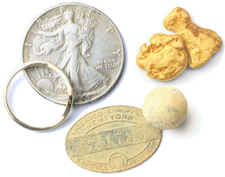 Part I: Basics of Using
the MXT Part I: Basics of Using
the MXT
The
MXT Edge is divided into two parts. In
Part I, the basics of using the MXT are covered.
Part II covers a number of advanced MXT topics such
as VDI numbers, ground mineralization, optional search
coil performance, and additional feature details that are
sure to be of vital interest to the serious hobbyist.
Chapter
One provides an overview of the book and the approach
used in the organization of information presented within
it. For example, the book is organized to both, be
read cover-to-cover and to serve as a reference. To
assist with the latter, individual sections repeat
important principles to allow those sections to better
stand on their own when used for reference.
Chapters
Two and Three provide an overview of the MXT, its
features, characteristics, and operation fundamentals.
Chapter
Four covers the MXT controls. One of the controls
is the "Mode Switch" which changes the basic
mode of operation or "program" that the MXT
runs. Chapter Five is dedicated to examining the
COIN & JEWELRY, RELIC, and PROSPECTING operating
modes.
The
next three chapters focus on hunting examples using these
three distinct operating modes.
Ending
Part I, Chapter Nine provides a number of additional tips
and techniques to enhance further the MXT operator's
abilities.
Part II: Advanced MXT Topics
In
Part II, a number of additional topics are presented to
compliment Part I and provide a more thorough
understanding of the technology of the MXT.
Basic
to the operation of the MXT is the VDI number system.
This "Visual Discrimination Indication"
system is at the heart of how the MXT reports target
information to the user. Chapter Ten takes a
detailed look at the VDI number system, the target and
ground factors that cause VDI numbers, and the
interaction between the VDI number system and other
features on the MXT.
The
MXT is constantly working to overcome the effects of
ground mineralization in the search for valuable targets.
Chapter Eleven examines the details of ground
mineralization, what PROSPECTING mode's GND numbers mean,
how to use them, how to estimate the strength of
iron-based mineralization, and much more.
Chapter
Twelve provides an in-depth feature summary organized
based on the MXT's internal design – not based on
the unit's knobs and switches. Need more
information about a feature? This chapter provides
a different perspective on the MXT's bells and whistles
and includes more in-depth discussion of some of the more
esoteric features.
Everything
the MXT finds must first be sensed by the search coil on
it. Chapter Thirteen takes a detailed look at the
five White's search coils currently available for the
MXT. 3-D sensitivity patterns for each search coil
are shown for both coin-sized and nugget-sized targets.
Graphs showing the results of performance testing
of the five search coils in different strengths of
ferrous ground mineralization are also included.
Appendix A. Important MXT Procedure
Cross-Reference
This
appendix provides a cross reference to these important
MXT procedures:
- How to ground-balance the MXT.
- How confirm the ground-balance is set properly.
- How to pinpoint targets with a concentric (round)
search coil.
- How to pinpoint targets with DD (oval) search
coil.
- How to verify peak stable discrimination mode
GAIN setting.
- How to estimate the strength of ferrous
ground-mineralization.
- When to set the TRAC switch to LOCK, SALT, or
GROUND.
Appendix B. Bench Test Illustrating MXT
Features
This
appendix provides bench tests to illustrate the MXT's
Self Adjusting Threshold and Mixed-Mode audio features.
Appendix C. Pinpointing Coil Dead-Zones
This
appendix provides 3-D graphs showing
"dead-zones" that occur very close to the
search coil that beginners, learning pinpointing skills,
should know about.
|